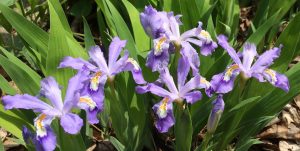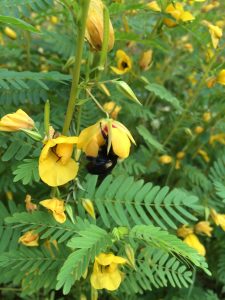Native Plant Container Gardening
Over the years, we’ve had a lot of requests from people who want to use containers for native plant gardening. They might have a balcony or reduced space or simply like containers. They want the beauty and biodiversity near them & containers are the way to go. We’ve not always had a lot of recommendations for them, but we have been experimenting and learning from other Wild Ones chapters as well as the larger native plant community who have been sharing their trials and errors. The good news from all this crowd-sourcing of information is that native plants can work in containers, some better than others, but the list is always expanding.
Basically, if you like a plant, give it a try! Make sure the container size fits the plants you are using. Be sure that the container will fit the plants at their mature sizes, not the 4″ pot or plug size. If you are growing multiple species in one container, the container should be fairly large.
Benefits of native plants in containers
Besides being able to have a garden in a place that would otherwise be impossible (balcony, etc), the benefits of using containers are many:
- easier to weed,
- easier to move pots to match sun and soil conditions,
- easier to care for more finicky plants,
- easier to observe wildlife if containers are near windows (be sure to use bird safe decals on windows)
- keep some aggressive spreaders contained.
Green Bay Chapter’s recommendations:
Over 10 years ago, Bonnie Vastag of the Green Bay chapter wrote a recap about their experiments with native plants: “Growing native plants in containers – does it work?” They found the following plants were very valuable in containers (in order of bloom time):
Spring blooms:
- Harebell (Campanula rotundifolia)
- Missouri primrose (Oenothera macrocarpa)
- Hairy Beardtonguepenstemon (Penstemon hirsutus)
- Ohio spiderwort (Tradescantia ohiensis)
Summer
- Anise Hyssop, (Agastache foeniculum)
- Prairie sage (Artemisia ludoviciana) Didn’t bloom for them but provided a nice, fresh accent (& carder bees love the fiber they can use from this plant to line their nests)
- Side oats grama (Bouteloua curtipendula)
- Clustered poppy mallow (Callirhoe triangulata)
- Wild Senna (Cassia hebecarpa) They found it particularly impressive. You would need a large pot.
- Coreopsis (Coreopsis lanceolata)
- Pale purple coneflower (Echinacea pallida)
- Purple coneflower (Echinacea purpurea).
- Tennessee coneflower (Echinacea tennesseenis).
- Rattlesnake master (Eryngium yuccifolium) Noted they had to stake it, but worth the extra attention because of its striking form (the “thrill”)
- False Sunflower (Heliopsis helianthoides)
- Prairie Junegrass (Koeleria macrantha)
- Showy Beardtongue (Penstemon grandiflorus)
- Gray headed coneflower (Ratibida pinnata)
- Little bluestem (Schizachyrium scoparium)
- Prairie dropseed (Sporobolus heterolepis.
Fall
- Sky blue aster (Aster azureus)
- The grasses would still be lovely
Species to add based on our experiences:
Some of our members have found that many of the below plants have worked well for them in containers and have successfully overwintered them:
Spring Blooms
- Wild Garlic (Allium canadense)
- Spring Beauty (Claytonia virginica)
 Dutchman’s Breeches (Dicentra cucullaria)
Dutchman’s Breeches (Dicentra cucullaria)- Shooting Stars (Dodacatheon media)
- Wild Geranium (Geranium maculatum)
- Crested Iris (Iris cristata)
- Pasque Flower (Pulsatilla patens)
Summer Blooms:
- Rose Milkweed (Asclepias incarnata)
- Purple poppy Mallow (Callirhoe involucrata)
- American Bellflower (Campanula americana)
- Partridge Pea (Chamaecrista fasciculata)
 Bottle Gentian (Gentiana andrewsii)
Bottle Gentian (Gentiana andrewsii)- Sneezeweed (Helenium autumnale)
- Rose Mallow (Hibiscus laevis)
- Liatris (Liatris spicata)
- Michigan Lily (Lilium michiganense)
- Cardinal Flower (Lobelia cardinalis)
- Blue Lobelia (Lobelia syphilitica)
- Penstemon species (P. hirsutus and P. digitalis)
- Bowman’s Root (Porteranthus trifoliata)
- Royal Catchfly (Silene regia)
- Fire Pink (Silene virginia)
- Hoary Vervain (Verbena stricta)
Fall Blooms
- Sneezeweed (Helenium autumnale)
- Gray Goldenrod (Solidago nemoralis)
- Asters (Symphyotricum species) Depending on the species and size of the container, the aster would be the main plant. Different asters have different habits and requirements, so it would be worth doing some research before using one in your planter. You could always check with us before using.
- Aromatic Aster is a gorgeous, mounding, very late blooming aster but can seem like a small shrub after it reaches maturity. It needs part-full sun.
- Sky Blue aster can be pruned before July 4 and will not take up as much space as Aromatic Aster.
- Calico Aster or Short’s Aster would work nicely in a part shade to shade conditions.
- The ubiquitous volunteer Drummond’s Aster can be pruned and planted in the back of the planter.
Experiment
Sometimes we love plants or want to try them but know we don’t quite have the perfect conditions for them. In that case, selecting an appropriate size container and soil mixture might allow us to have plants that wouldn’t normally survive here. There might be some objections to this, but we think being flexible with what we plant and experimenting with things is not harmful, certainly not any more than what can often get purchased at garden stores. Why not try Wild Blue Lupine (Lupinus perennis) in a mixture of organic potting soil and cactus mix?
Seed Spring Ephemerals
One other benefit that deserves special mention is that many spring ephemeral seeds need what’s called a double dormancy period. They need a warm moist period followed by a cold moist period. Sowing the seeds in the garden can make it difficult to track the seeds and ensure that they stay moist during the summer. Sowing the seeds amidst appropriate plants in the container is an ideal solution because a.) it will be warm b.) moisture is guaranteed because you’ll be watering c.) the seeds can easily sprout the next spring when the other plants won’t likely be up yet. Be sure to sow seeds with plants that have matching conditions.
Drawbacks
Despite all this good news, there are some drawbacks to containers: keeping the plants watered and helping them overwinter. In full sun and hot weather, containers can dry out quickly, especially if you have mature plants that suck up the water pretty quickly. You may need to move them to a larger pot or just be sure to water them on a regular basis. You can use leaf mulch to help retain some moisture.
Depending on the weather during the winter, overwintering the pots are either an issue or not. When plants are in the ground, their root systems are fairly insulated. In a container, their roots are above ground and are therefore more exposed to the cold. In a mild or typical winter, you can probably get away with letting the pots stay outside or perhaps closer to the house to take advantage of a natural microclimate for your plants in their containers. Snow banks will also help to insulate the pots. You can always move the pots to a spot where they will be more protected from the elements but still get moisture and stay cold so that their dormancy doesn’t get prematurely broken. If there is going to be a polar vortex, it’s a good idea to move the pots into a more protected location temporarily like an unheated garage or basement. Don’t forget to bring them out once the temps move back up into normal range. Be sure to get containers that can take the outdoor weather too.
We’re excited about the possibilities offered by native plants in containers! More people can support the ecosystem through using containers and get the satisfaction out of growing plants they might not be able to in their gardens.
In April 2024, we had a presentation on Container Gardening. Here is a link to the recording: Container Gardens
Further reading:
Missouri Botanic Garden has more information. Not all of the plants they list will be native to IL, but the majority are. They have suggestions and planting diagrams for what looks like large containers.
Ecobeneficial has some great tips to keep in mind. Check out #11: create themes with your containers!
University of Wisconsin-Madison has some inspirational pictures of cedar boxes on an apartment balcony
Embassy Landscape Group discusses other reasons to consider native plants for containers (annuals are very resource intensive & grown potentially with neonicotinoids and other pesticides that are not helpful for bees, butterflies, and birds. These pesticides can be downright harmful).
